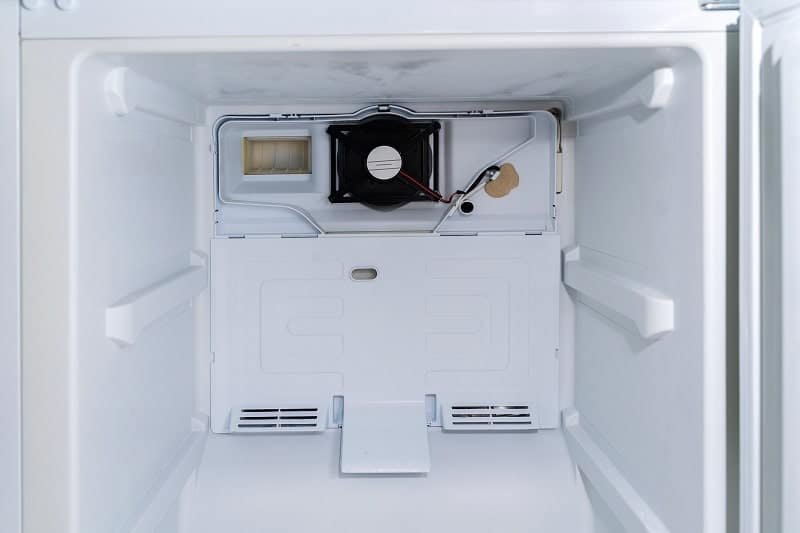We've independently reviewed this article to make sure it's as accurate as we can make it.
To find out more about our article creation and review process, check out our editorial guidelines.
Are you frustrated because your freezer is cold, but your refrigerator is warm?
If so, you might be concerned that your food will spoil in the refrigerator. So let’s figure out what the issue is so that we can address it quickly.
If your freezer is cold but your refrigerator’s warm, first ensure you haven’t overfilled the fridge. Then check that there’s good airflow around the refrigerator and the vents are clear. Inspect the evaporator fan and the coils at the rear/base of the fridge.
Keep reading to learn more about how to solve the issue!
Why trust us? This article was written by Craig Anderson and Andy Fulenchek.
Craig has helped thousands of other homeowners repair their appliances since 2016.
Andy is one of our resident appliance repair experts with over a decade of experience. He currently runs his appliance repair company with a team of trusted technicians.
Fixing A Warm Fridge And Cold Freezer: 5 Simple Steps
To make things easier for you, in this section, you’ll find step-by-step instructions that will help you get rid of the issue.
#1 Grab Your Gear
There are several materials you need to collect when your fridge is warm, and your freezer is cold or when your appliance fails in any way. The materials include:
- Manufacturer’s manual: If you can’t find the manual, don’t worry! Check out our ultimate guide to finding any product manual online.
- Cleaning solution and a tower or microfiber cloth.
- Soft brush.
- Towels.
After you have collected all the materials mentioned above, it is time to take a closer look at what you need to do to a warm refrigerator.
#2 See How You Packed the Freezer
The first thing you need to do when your fridge is warm but your freezer’s cold is to look at how you have packed the freezer. You may not realize that the way you load the freezer can have a significant impact on the temperature in the refrigerator.
If you have a single evaporator freezer/refrigerator, the fridge section gets its cold air from the freezer. There is a vent (usually called a damper door) through which the evaporator fan motor forces air.
Unfortunately, if food is blocking the damper door, you’ll have an airflow issue that is likely the cause of the warm temperature in the fridge.

If you want to fix the issue, I usually advise removing some items from your freezer. Then, you’ll want to move the items to the refrigerator instead, or you may wish to simply consume them.
Once there is enough room for the air to flow, allow 12–24 hours to achieve proper cooling again. Leaving the doors shut during this time will help speed up the process.
Provided you clear the damper door, and there’s still no change, check whether it’s being kept open due to freezing o or failure.
#3 Clean the Vents in the Freezer
As you start to rearrange the items, you need to take a closer look at the ability of the air to flow from the freezer to the refrigerator.
If you look at the vents, and they look like they have a bunch of debris, you need to clean them. You’ll want to combine a cleaning solution with a spray bottle and spray down the vents. Then, clean the vents with a microfiber cloth.
In my opinion, using warm water is best for the task. By using warm water, you don’t have to worry about it freezing the instant it hits the vent.
If there’s ice all over the vent, it won’t work properly. Ensure you wipe down the vent thoroughly with a towel when finished. If you’ve already cleaned the vents and the refrigerator is still not working properly, it is time to move on to the next option.
#4 Take a Closer Look at the Evaporator Fan
Another possible reason why your fridge is warm and your freezer is cold is a fault with the evaporator fan.
Many refrigerators use a fan to move cold air from the freezer to their compartment. As the air moves from the freezer to the refrigerator, it will warm up slightly, but not so much that it causes your food to spoil.
I’ve found that if the evaporator fan is not running, you’ll have a lot of cold air in the freezer, but the refrigerator may appear to be a bit warm. You must take a closer look at the evaporator fan to ensure it’s working correctly.
Please get your manual to determine where the evaporator fan is located, as its playing can vary between brands and models. Don’t forget to ensure the fan blades are properly installed!
In many cases, the evaporator fan is located behind the wall of the freezer. If you look in the back of the refrigerator, you should be able to find the evaporator fan.

You must check the fan to ensure it’s spinning freely. There may be a few screws that you need to remove to access the evaporator fan.
If the evaporator fan is still not spinning, you must replace it. Please get in touch with a professional to handle the replacement.
#5 Have You Defrosted the System Recently?
Excess frost can also explain why your fridge is warm, but your freezer is cold.
If you do not defrost a refrigerator and freezer occasionally, your freezer can start to create excess ice in the wrong place, such as in the vents and evaporator coils.
In such cases, cooling capacity is decreased because the evaporator fan isn’t able to pull air across the evaporator coils any longer and can’t circulate the cold air between the cabinets.
You must remove excess ice from your system’s interior if you want your freezer and refrigerator to work properly.
Your refrigerator likely has a defrost system that includes a timer, which can be integrated as part of the electronic control board. In my experience, the system should run several times per day, and its main purpose is to remove frost from the freezer and the refrigerator where it is not warranted.
However, excess frost can appear when the system doesn’t run as it should.
If you don’t have an automatic defrost system, you may have to defrost your appliance manually. To do so, you must remove all the items from your freezer and refrigerator, place them to the side, and then unplug the entire system.
As the system warms up, the ice will melt. You’ll need to put a bunch of towels around the bottom of the freezer in the refrigerator to avoid puddles from the melted ice.
The defrosting process can be sped up by allowing a fan to blow warmer air from the room into the freezer space. Allow 12–24 hours for the fridge to fully defrost.
After the system has defrosted completely, you can plug it back in again. Please allow 24 hours with doors closed before returning food to the unit.
If your freezer doesn’t have an automatic defrost system, my usual advice is to manually defrost it occasionally to allow the evaporator coils and the vents to work properly.
Estimated Repair Costs
Although the repair costs for different problems with your refrigerator will vary, I’ll do my best to provide you with some ballpark estimates to help you determine whether a repair is worth paying or if you should buy a new refrigerator instead.
| Damper Door Issues | $250-$400 |
| Temperature Sensor Issues | $200 |
| Defrost Issues | $200-$400 |
| Evaporator Fan Motor Issues | $185-$300 |
Correcting Your Refrigerator’s Temperature
That about covers it!
In general, you want your refrigerator to be cool, but you do not want it to be as cold as your freezer. Ideally, your freezer should sit around 0 °F, and your refrigerator should sit between 37 °F and 38 °F.
Remember that there’s a system supposed to take the cold air from the freezer and pump it into the refrigerator.
The first thing you must inspect if your refrigerator is warm is how you pack the freezer. If too many items are in the freezer, the refrigerator won’t be able to cool properly.
Thanks for reading. If this article was useful and answered your questions, please check out our other resources below and consider subscribing to our newsletter.
Have a wonderful day!
-Craig.







